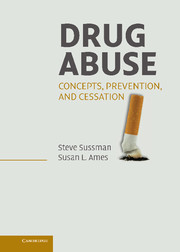Book contents
- Frontmatter
- Contents
- Preface
- Acknowledgments
- SECTION ONE CONCEPTS AND CLASSES OF DRUGS
- SECTION TWO ETIOLOGY
- SECTION THREE PREVENTION
- SECTION FOUR CESSATION
- 15 Concepts of Cessation
- 16 Neurobiologically Relevant
- 17 Cognitive Processes
- 18 Social Interaction and Social Groups
- 19 The Large Social and Physical Environment
- SECTION FIVE CONCLUSIONS AND THE FUTURE
- References
- Author Index
- Subject Index
15 - Concepts of Cessation
Published online by Cambridge University Press: 18 December 2009
- Frontmatter
- Contents
- Preface
- Acknowledgments
- SECTION ONE CONCEPTS AND CLASSES OF DRUGS
- SECTION TWO ETIOLOGY
- SECTION THREE PREVENTION
- SECTION FOUR CESSATION
- 15 Concepts of Cessation
- 16 Neurobiologically Relevant
- 17 Cognitive Processes
- 18 Social Interaction and Social Groups
- 19 The Large Social and Physical Environment
- SECTION FIVE CONCLUSIONS AND THE FUTURE
- References
- Author Index
- Subject Index
Summary
Cessation of substance abuse is commonly linked to consequences of use. For example, an individual may experience legal consequences, such as being arrested, resulting in court mandated treatment. An individual may experience social consequences, such as interpersonal conflict related to use, and may be persuaded to enter a treatment program as a result. An individual may suffer an accident such as a car crash or near-drowning while under the influence (consequences related to use in dangerous situations). An individual may acknowledge the need for treatment after losing his/her job, home, car, friends, and family (job and personal role and social consequences). Alternatively, an individual may merely feel socially isolated, alienated, and fraught with physical reactions (e.g., shakes) that are unpleasant. There are many possible scenarios that bring individuals into treatment, but most are linked to negative consequences of use.
Although withdrawal symptoms from drug use will differ in length and severity of withdrawal reactions, depending on the drug or drugs used, treatment of substance abuse usually begins with withdrawal from whatever drug or drugs an individual has been abusing. Some individuals may be serving prison time for substance-related problems and are forced to withdraw in an unforgiving environment, whereas others may be medically supervised or able to withdraw from substances in more supportive environments. Even getting through this initial period of withdrawal continues to challenge practitioners, researchers, and the substance-abusing individual (Weil & Rosen, 1993).
In addition, program attrition or compliance to program protocols continues to challenge treatment program providers.
- Type
- Chapter
- Information
- Drug AbuseConcepts, Prevention, and Cessation, pp. 207 - 224Publisher: Cambridge University PressPrint publication year: 2008



